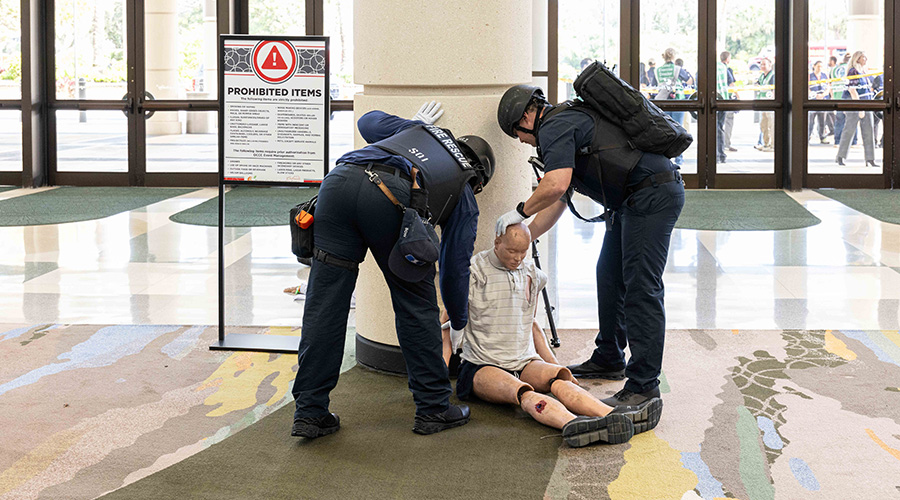How Facility Managers Can Protect Occupants From H1N1
Once employees have been properly cross-trained, facility executives also need ensure that steps are taken to reduce the risk of occupants getting sick in the workplace.
The bottom line is that the more confident employees are that steps are being taken to protect them, the more likely they are to continue to show up for work.
“There is a chance people could be quite frightened by this,” says Koonin. “People need to know the reality from fiction. They need to know what the employer is doing and what the employer plans to do.”
There are a number of basic steps facility executives can consider. Implementing a social distancing policy is one way to reduce the risk of occupants infecting each other. The idea, basically, is to keep occupants from congregating. Consider teleconferences instead of group meetings. If the organization has extra space, consider spreading employees further apart in cubicles. If it’s feasible, stagger work shifts.
One utility in California that had customers drop payments off in its lobby installed a drive-up window when H1N1 appeared last spring.
“Everyone got a mailer with their utility bill about the new process,” says Casavant. “They took a potentially disruptive situation and turned it into a positive.”
If the organization uses hotelling in some spaces where employees share space throughout the day, facility executives should provide hand sanitizer and surface cleaning wipes in those locations and leave instructions for employees to sanitize the stations when they enter and leave, Rosenbluth says.
If facility staff is stocking up on items such as cleaners and hand sanitizers that have expiration dates, make sure that items with the oldest non-expired dates are used first.
Also realize that the prices of some supplies may fluctuate during an especially severe pandemic. If certain types of supplies can’t be disrupted, now is the time to have a conversation with suppliers about the cost of priority delivery, says Kumar. In such situations, facility executives may have to prepare for price fluctuations or cash payments, Kumar says.
It’s also a good idea to touch base with cleaning contractors. Though many will have appropriate procedures in place, it’s worthwhile to make sure that surfaces that are commonly touched by more than one person — such as elevator controls and doorknobs — are wiped down at least once a day, says Koonin.
Though the flu virus can survive for around eight hours on a hard surface, Koonin says that is not the way most people get infected. Instead, most people get infected through germs spread by coughing, sneezing or being touched by someone who just coughed or sneezed into their hands, she says.
That means cleaning is no substitute for reminding occupants to practice proper hand washing and cough etiquette. “The most important message is we need to be more vigilant about good health practices in general,” says Levi, who also says having sanitizer available in restrooms and lobbies and posting signs in restrooms urging hand washing are both simple and important.
Finally, disruptions can come from more than just absent employees. Absent service providers can be just as big a problem — especially when it comes to things like janitorial service. If the service is key to keeping a building open, it’s imperative to have conversations now with service providers about how they intend to keep operating. If necessary, arrange for backup service providers.
“I think everyone in your supply chain and everyone you contract with needs to know what your plans are and what you are expecting of them,” Koonin says. “Make sure the people you depend on are planning and preparing.”
The Importance of Service Providers
Simply assuming that service providers are doing the proper planning for the H1N1 pandemic is gambling, even if the service provider in question has a relationship that extends for years.
Casavant recalls working for a utility company that had power plants struck by Hurricane Andrew in 1992. The utility knew a hurricane would cause widespread power outages, so it contracted to have a pallet of portable generators delivered to the plant. The goal was to make sure employees had power so they could stay in their homes and keep coming to work, rather than being forced to evacuate.
Unfortunately, the utility company didn’t check to make sure its security firm would continue to function. And so the generators were dropped off within 12 hours, but with the fences knocked down by the hurricane and the security contractors evacuated, the generators never made it to employees.
“You could drive to work and hear all those generators in the neighborhood and you knew they had been delivered to the plant,” says Casavant.
Aside from making sure service providers are ready, the story hints at a second lesson: Communicate H1N1 plans early, says Rosenbluth. The reason? It builds confidence. Feedback from employees can also serve as a reality check on the plans.
“I think companies letting their employees know there is a corporate plan to deal with H1N1 and providing them with the information well before there are cases breaking out again is the right thing to do,” Rosenbluth says. “It enables them to get out in front of the issues with tenants and clients.”
Related Topics:














